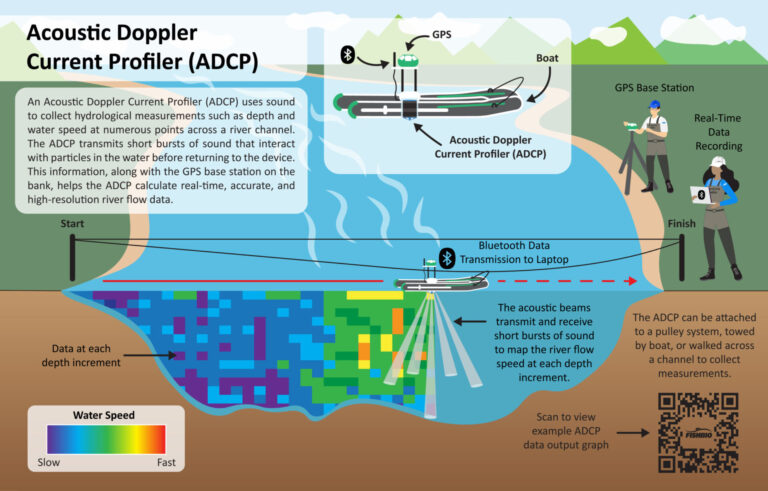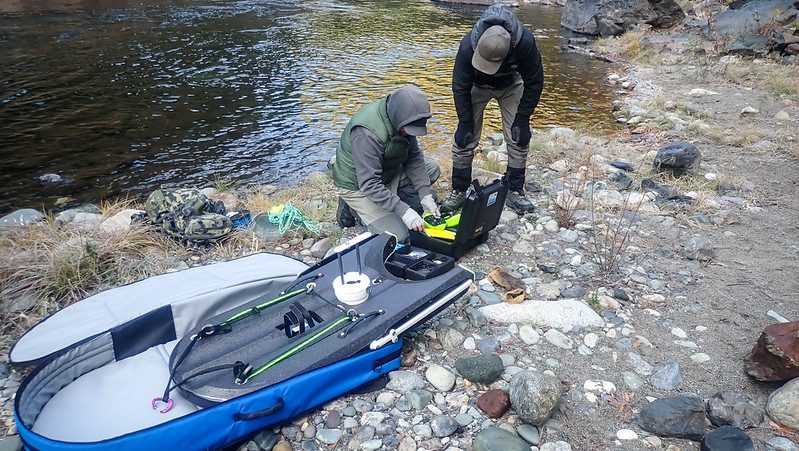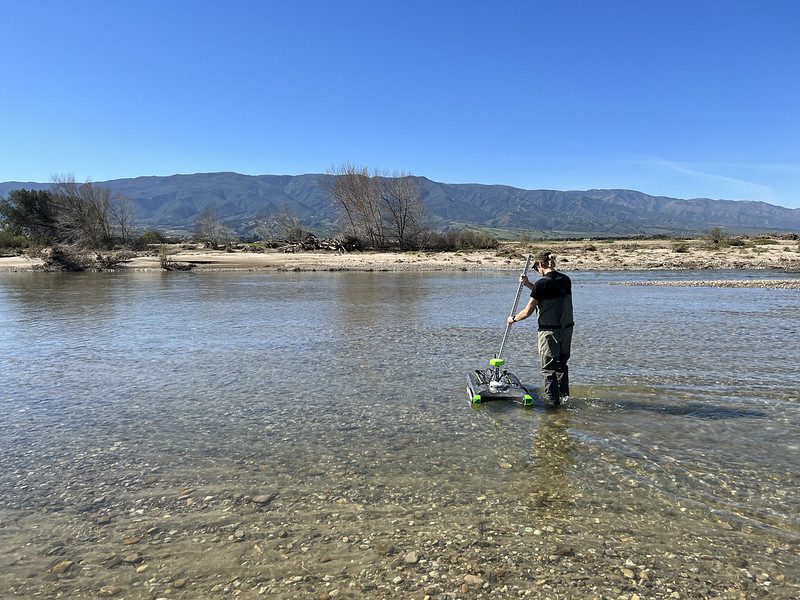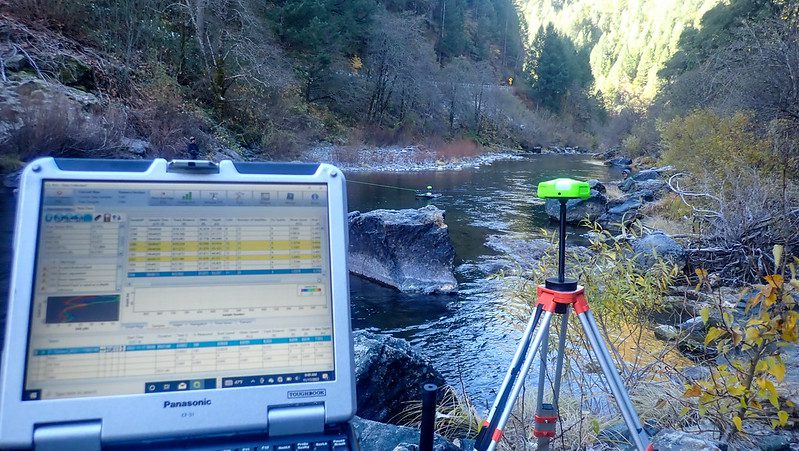Monday April 24, 2023

Hydrology, or the study of the physical and chemical properties of water, goes hand in hand with fisheries management. In fact, most fisheries biologists use hydrological tools and techniques to develop and inform effective fisheries management practices. FISHBIO recently purchased a SonTek RS5 acoustic doppler current profiler (ADCP), expanding our hydrological toolkit. This device allows biologists to collect physical measurements of a river in a safer, more efficient, and more accurate way. The ADCP calculates a river’s flow – also known as discharge – using sonar. The resulting data on the velocity, depth, flow, and relationships between these factors can help fisheries biologists better understand the conditions that fish are encountering in a given location.

An ADCP determines a river’s flow rate by sending “pings” of sound waves from the surface toward the river bottom, and some of these pings are reflected back to the device after interacting with particles suspended in the water. The pattern in which these pings return to the device allows the ADCP to calculate the speed of the water at any point between the surface and the bottom. The changes in the property of sound waves as they reflect off moving objects, also known as the Doppler Effect, allow researchers to gain critical information in a variety of scientific fields. In fact, the Doppler Effect has been leveraged for tasks varying from tracking incoming storms to diagnosing heart problems. For fisheries and hydrological research, ADCPs can be mounted to a moving boat or to the side of a canal, and are used to identify critical flow speeds within a riverbed, track streambed change due to erosion, and monitor tidal flows. ADCPs have recently been used to identify effective flow rates for fish at hydropower dams and at fish guidance structures. The ADCP’s abilities have even allowed biologists to adapt this technology to observe zooplankton movement patterns and measure plastic transport in the Mekong River.

The RS5 comes equipped with general ADCP tools, including a clock, thermometer, compass, and pitch/roll sensor. In addition to the transducers that emit pings and the hydrophones that listen for the returning pings, the ADCP also is equipped with Bluetooth to send data in real-time to an external computer. The ADCP factors in and corrects for streambed and boat movement during operation, and the RS5 in particular comes with software that conducts real-time corrections, providing detailed and accurate measurements of flow from the river bottom to the river’s edge. The RS5 is a compact type of ADCP, as this high-tech device is mounted to a floating platform about the size and shape of a boogie board, also referred to as the HydroBoard or “boat.” The board is connected to a rope that is used to guide it across a river channel from one side to the other. Equipped with five transducers, the RS5 software uses an intelligent algorithm to adjust to conditions automatically. The RS5 can detect flow across varying depths with a 2.5-centimeter (0.98-inch) resolution and accuracy within 1% of measured values. It works in water depths ranging from 0.1 to 6 meters (3.9 inches to 19.7 feet), water velocities ranging from 0 to 5 meters/second (0 to16 feet/second), and temperatures ranging from -5 to 45°C (23 to 113°F). The RS5 ADCP is equipped to collect stationary, mid-section, or mean-section measurements which are the common methods used to manually make discharge estimates, and the data it collects can be exported to Excel, Matlab (Extrap), and Google Earth. This makes the technology compatible with current protocols that agencies require for discharge measurements. The RS5 also has an optional Geode antenna with real-time kinematic (RTK) or network communication that allows satellites to track the RS5 location and record measurements every second, providing more precision than many other ADCPs on the market.

ADCPs are valuable tools that allow fisheries scientists and hydrologists to collect highly detailed and accurate streambed data. They can function in very shallow and slow, or deep and fast waterways. The most significant advantage of the RS5 over other ADCPs is its compact size and self-contained design, with two internal rechargeable lithium-ion batteries that last for seven hours of continuous use. SonTek’s HydroBoard II Micro is compact and comes with a backpack carrying case, making it easily transportable. With nothing else needed except for a computer and ropes, two people can easily operate the device.

FISHBIO has already used the ADCP to help determine the best location to install a rotary screw trap on the North Fork Yuba River, and to evaluate passage flows for steelhead (Oncorhynchus mykiss) in a coastal California watershed. The ADCP will be a valuable tool in much of the work FISHBIO does, including project planning, habitat assessments, watershed monitoring, and construction projects. Please contact FISHBIO if you think an ADCP might be needed for your next project.
This post was featured in our weekly e-newsletter, the Fish Report. You can subscribe to the Fish Report here.
